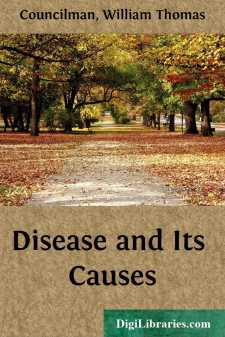Categories
- Antiques & Collectibles 13
- Architecture 36
- Art 48
- Bibles 22
- Biography & Autobiography 813
- Body, Mind & Spirit 142
- Business & Economics 28
- Children's Books 16
- Children's Fiction 13
- Computers 4
- Cooking 94
- Crafts & Hobbies 4
- Drama 346
- Education 46
- Family & Relationships 57
- Fiction 11829
- Games 19
- Gardening 17
- Health & Fitness 34
- History 1377
- House & Home 1
- Humor 147
- Juvenile Fiction 1873
- Juvenile Nonfiction 202
- Language Arts & Disciplines 88
- Law 16
- Literary Collections 686
- Literary Criticism 179
- Mathematics 13
- Medical 41
- Music 40
- Nature 179
- Non-Classifiable 1768
- Performing Arts 7
- Periodicals 1453
- Philosophy 64
- Photography 2
- Poetry 896
- Political Science 203
- Psychology 42
- Reference 154
- Religion 513
- Science 126
- Self-Help 84
- Social Science 81
- Sports & Recreation 34
- Study Aids 3
- Technology & Engineering 59
- Transportation 23
- Travel 463
- True Crime 29
Disease and Its Causes
Categories:
Description:
Excerpt
Chapter I
Definition Of Disease.—Characteristics Of Living Matter.—Cells As The Living Units.—Amoeba As Type Of A Unicellular Animal.—The Relation Of Living Matter To The Environment.—Capacity Of Adaptation To The Environment Shown By Living Matter—Individuality Of Living Matter.—The Causes Of Disease.—Extrinsic.—The Relation Of The Human Body To The Environment.—The Surfaces Of The Body.—The Increase Of Surface By Gland Formation.—The Real Interior Of The Body Represented By The Various Structures Placed Between The Surfaces.—The Fluids Of The Body.—The Nervous System.—The Heart And Blood-Vessels.—The Cells Of The Blood.—The Ductless Glands.
There is great difficulty, in the case of a subject so large and complex as is disease, in giving a definition which will be accurate and comprehensive. Disease may be defined as "A change produced in living things in consequence of which they are no longer in harmony with their environment." It is evident that this conception of disease is inseparable from the idea of life, since only a living thing can become diseased. In any dead body there has been a preëxisting disease or injury, and, in consequence of the change produced, that particular form of activity which constitutes life has ceased. Changes such as putrefaction take place in the dead body, but they are changes which would take place in any mass similarly constituted, and are not influenced by the fact that the mass was once living. Disease may also be thought of as the negation of the normal. There is, however, in living things no definite type for the normal. An ideal normal type may be constructed by taking the average of a large number of individuals; but any single individual of the group will, to a greater or less extent, depart from it. No two individuals have been found in whom all the Bertillon measurements agree. Disease has reference to the individual; conditions which in one individual would be regarded as disease need not be so regarded in another. Comparisons between health and disease, the normal and the abnormal, must be made not between the ideal normal and abnormal, but between what constitutes the normal or usual and the abnormal in a particular individual.
The conception of disease is so inseparably associated with that of life that a brief review of the structure and properties of living things is necessary for the comprehension of the definition which has been given. Living matter is subject to the laws which govern matter, and like matter of any other sort it is composed of atoms and molecules. There is no force inherent in living matter, no vital force independent of and differing from the cosmic forces; the energy which living matter gives off is counterbalanced by the energy which it receives. It undergoes constant change, and there is constant interchange with the environment. The molecules which compose it are constantly undergoing change in their number, kind and arrangement. Atom groups as decomposition products are constantly given off from it, and in return it receives from without other atom groups with which it regenerates its substance or increases in amount....


